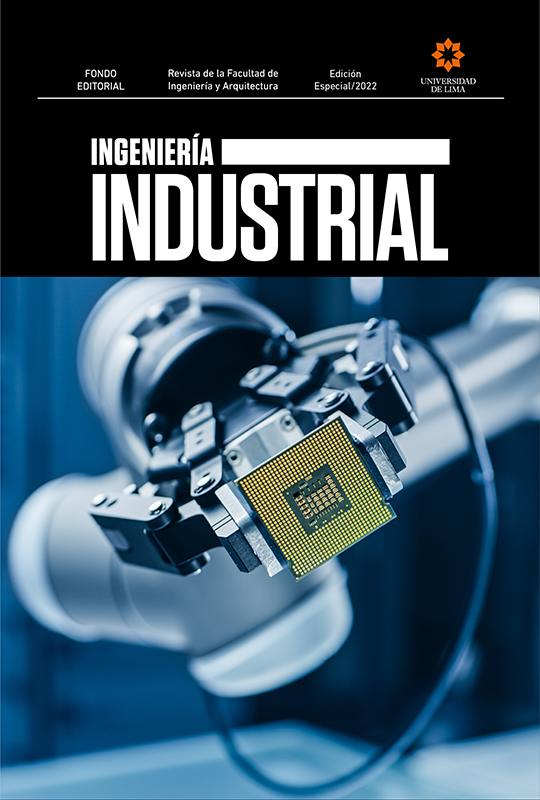Design and construction of a control and tracking system based on servomotors to optimize the angle of incidence of solar radiation
DOI:
https://doi.org/10.26439/ing.ind2022.n.5803Keywords:
solar energy, energy conversion, photoresistors, solar panels, servomechanisms, control systemsAbstract
The research project consists of the design and construction of a prototype of a two-axis solar tracking system, which is based on automation using Arduino IDE programming software with photoresistors for positioning the photovoltaic module, in order to optimize the capture of solar radiation. The result of the development of the experimental test has allowed concluding that the greatest power generation has been achieved by using an ACS712 sensor, achieving measurements of greater solar radiation between 10:00 a. m. and 5:00 p. m. of the day. Likewise, between 11:45 a. m. and 1:00 p. m. a current is produced that oscillates between 0,60 A and 0,62 A, achieving optimal performance and with the fixed position system 0,60 A is reached at 10:45 a. m. and it remains constant between 0,60 A and 0,62 A until 1:45 p. m. The average power obtained for the panel in a fixed position is 5,37 watts for 7 hours, while when applying the solar tracking system 6,1 watts were reached, producing an increase of 13,67 %.
Downloads
References
Barragán, E., Zalamea, E., Terrados, J., & Vanegas, Pablo. (2019). Factores que influyen en la selección de energías renovables en la ciudad. EURE (Santiago), 45(134), 259-277. https://dx.doi.org/10.4067/S0250-71612019000100259
Chakraborty, S., Das, S., Sadhu, P. K., & Sastry, O. S. (2015). Design and experimental execution of a microcontroller (μC)‐based smart dual‐axis automatic solar tracking system. Energy Science & Engineering, 3(6), 558-564. http://dx.doi.org/10.1002/ese3.102
Dalmazzo-Bermejo, E., Valenzuela-Klagges, B., & Espinoza-Brito, L. (2017). Producción de energía renovable no tradicional en América Latina: economía y políticas públicas. Apuntes. Revista de Ciencias Sociales, 44(81), 67-87. http://dx.doi.org/10.21678/apuntes.81.806
El Hammoumi, A. E., Motahhir, S., Ghzizal, A. E., Chalh, A., & Derouich, A. (2018). A simple and low‐cost active dual‐axis solar tracker. Energy Science & Engineering, 6(5), 607-620. http://dx.doi.org/10.1002/ese3.236
Feron, S., & Cordero, R. R. (2018). Is Peru prepared for large-scale sustainable rural electrification? Sustainability, 10(5), 1683. http://dx.doi.org/10.3390/su10051683
Guaita-Pradas, I., & Blasco-Ruiz, A. (2020). Analyzing profitability and discount rates for solar PV plants. A Spanish case. Sustainability, 12(8), 3157. http://dx.doi.org/10.3390/su12083157
Mansouri, A., Krim, F., & Khouni, Z. (2018). Design of a prototypical dual-axis tracker solar panel controlled by geared dc servomotors. Scientia Iranica, 25(6), 3542-3558. http://dx.doi.org/10.24200/sci.2018.20045
Qamar, U. H. (2019). Design and implementation of solar tracker to defeat energy crisis in Pakistan. International Journal of Engineering and Manufacturing, 9(2), 31. http://dx.doi.org/10.5815/ijem.2019.02.03
Rivera, H., Quintana, M., & Teixeira, V. (2016). Implementación de un sistema fotovoltaico en el distrito de San Borja, para aprovechar la energía solar durante los meses de verano. Tecnia, 26(1), 115. https://doi.org/10.21754/tecnia.v26i1.13
Talamon, A., Papp, R. V., Vokony, I., & Hartmann, B. (2019). Global solar energy trends and potential of building sector in Hungary. Interdisciplinary Description of Complex Systems, 17(1-A), 51-57. http://dx.doi.org/10.7906/indecs.17.1.7
Umbarila Valencia, L. P., Alfonso Moreno, F. L., & Rivera Rodríguez, J. C. (2015). Importancia de las energías renovables en la seguridad energética y su relación con el crecimiento económico. Revista de Investigación Agraria y Ambiental, 6(2), 231-241. https://doi.org/10.22490/21456453.1419



